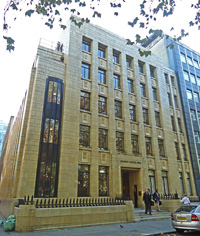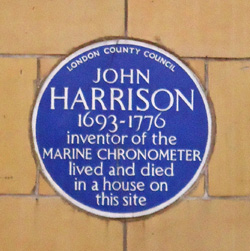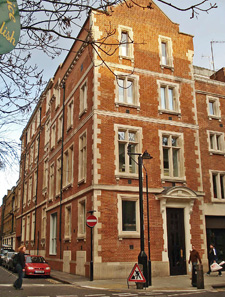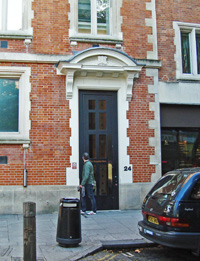St Paul's Hospital
24 Endell Street, Covent Garden, WC2H 8AE
Medical dates:
Medical character:
Specialist
St Paul's Hospital for Skin and
Genito-Urinary Diseases opened on 15th August
1898 as
an Out-Patients clinic at No. 13a Red Lion Square. It had been
founded following a meeting on 27th May 1897, called by the surgeon Mr
Felix Vinrace and held at the Midland Grand Hotel, to discuss the great
need for such a hospital.
The Hospital provided treatment primarily for venereal disease (or 'cognate diseases' as coyly named by its founding fathers) and had every modern convenience, including electricity. Male out-patients were seen on Mondays, Wednesdays and Saturdays, and women and children on Tuesdays, Thursdays and Fridays. Some clinics were held in the evenings so that patients did not have to lose a day's pay.
The large inscription in front of the Hospital - "For Skin and Genito-Urinary Diseases" caused concern to some residents, who felt it indecent, but the Hospital Governors were unmoved.
In its first year, 16 surgical procedures were undertaken, with no fatalities. Some 7,100 out-patient attendances were made, including 1,142 new cases.
Six in-patient beds were provided from time to time when finances allowed. Finances, indeed, were always critical, especially when the Secretary absconded with £235 5s. 6d. in 1904. He died in King's College Hospital while the Public Prosecutor considered what to do.
By 1904 the Hospital employed four surgeons and two anaesthetists.
While debts mounted, patients continued to pour in. By 1913 income began to rise above expenditure but there remained a debt of £2400.
A new drug - '606' (Salvarsan) - for the treatment of syphilis was first tried in 1913. In the same year, an X-ray apparatus was installed.
At the outbreak of WW1 the Hospital had to be reorganised again. In 1916 a government-funded clinic for free secret treatment of venereal disease (VD) was opened (St Paul's was one of 22 London hospitals selected for these clinics). In that year 20 in-patients were treated for skin diseases and 606 for VD; 20,000 out-patients were seen.
New premises were needed and, in 1919, the Committee of Management purchased for £15,000 the former British Lying-In Hospital building in Endell Street, which had been vacated when that Hospital merged with the Hospital for Mothers and Babies in Woolwich in 1913.
By 1921 the overdraft was £20,000 and work at the new Hospital was held up. Because of the financial difficulties, the new Hospital wasn't occupied until 1923 - the Red Lion Square building closing on Friday, 7th April, and the Endell Street building opening on Monday, 9th April "without friction".
In 1926 a lift was installed, as well as a cystoscopy room. Postgraduate teaching in urology began.
In 1927 the name of the Hospital changed to St Paul's Hospital for Diseases (including Cancer) of the Genito-Urinary Organs and Skin. An operating theatre and the X-ray department were newly equipped and a ward was opened with 18 beds.
In 1930 a separate department specifically for VD opened. Finances generally improved and a pathology laboratory was opened in 1936.
In 1939 at the beginning of WW2 the staff were called for duties with the Royal Army Medical Corps and the Hospital was closed. However, due to popular demand, it had to be reopened and continued to work within wartime limitations. In 1942 the LCC took over the VD clinic
In 1948 with the inauguration of the NHS, St Paul's and St Peter's Hospitals were amalgamated into a postgraduate teaching hospital group. The other urological hospital, All Saints', did not join this group but merged with the Westminster Hospital. Another urological hospital, St Philip's, also joined this group later, when it became known informally as 'the three Ps'.
St Paul's Hospital, with 49 beds, closed in 1992 and services moved to the Middlesex Hospital.
The Hospital provided treatment primarily for venereal disease (or 'cognate diseases' as coyly named by its founding fathers) and had every modern convenience, including electricity. Male out-patients were seen on Mondays, Wednesdays and Saturdays, and women and children on Tuesdays, Thursdays and Fridays. Some clinics were held in the evenings so that patients did not have to lose a day's pay.
The large inscription in front of the Hospital - "For Skin and Genito-Urinary Diseases" caused concern to some residents, who felt it indecent, but the Hospital Governors were unmoved.
In its first year, 16 surgical procedures were undertaken, with no fatalities. Some 7,100 out-patient attendances were made, including 1,142 new cases.
Six in-patient beds were provided from time to time when finances allowed. Finances, indeed, were always critical, especially when the Secretary absconded with £235 5s. 6d. in 1904. He died in King's College Hospital while the Public Prosecutor considered what to do.
By 1904 the Hospital employed four surgeons and two anaesthetists.
While debts mounted, patients continued to pour in. By 1913 income began to rise above expenditure but there remained a debt of £2400.
A new drug - '606' (Salvarsan) - for the treatment of syphilis was first tried in 1913. In the same year, an X-ray apparatus was installed.
At the outbreak of WW1 the Hospital had to be reorganised again. In 1916 a government-funded clinic for free secret treatment of venereal disease (VD) was opened (St Paul's was one of 22 London hospitals selected for these clinics). In that year 20 in-patients were treated for skin diseases and 606 for VD; 20,000 out-patients were seen.
New premises were needed and, in 1919, the Committee of Management purchased for £15,000 the former British Lying-In Hospital building in Endell Street, which had been vacated when that Hospital merged with the Hospital for Mothers and Babies in Woolwich in 1913.
By 1921 the overdraft was £20,000 and work at the new Hospital was held up. Because of the financial difficulties, the new Hospital wasn't occupied until 1923 - the Red Lion Square building closing on Friday, 7th April, and the Endell Street building opening on Monday, 9th April "without friction".
In 1926 a lift was installed, as well as a cystoscopy room. Postgraduate teaching in urology began.
In 1927 the name of the Hospital changed to St Paul's Hospital for Diseases (including Cancer) of the Genito-Urinary Organs and Skin. An operating theatre and the X-ray department were newly equipped and a ward was opened with 18 beds.
In 1930 a separate department specifically for VD opened. Finances generally improved and a pathology laboratory was opened in 1936.
In 1939 at the beginning of WW2 the staff were called for duties with the Royal Army Medical Corps and the Hospital was closed. However, due to popular demand, it had to be reopened and continued to work within wartime limitations. In 1942 the LCC took over the VD clinic
In 1948 with the inauguration of the NHS, St Paul's and St Peter's Hospitals were amalgamated into a postgraduate teaching hospital group. The other urological hospital, All Saints', did not join this group but merged with the Westminster Hospital. Another urological hospital, St Philip's, also joined this group later, when it became known informally as 'the three Ps'.
St Paul's Hospital, with 49 beds, closed in 1992 and services moved to the Middlesex Hospital.
Present status (December 2007)
The building was sold in 1996 and refurbished. It opened in 2003 as 'The Hospital', a media club and restaurant.
The building was sold in 1996 and refurbished. It opened in 2003 as 'The Hospital', a media club and restaurant.

Summit House now occupies the original site of the Hospital at No. 13a Red Lion Square.

A blue plaque on the wall of Summit House commemorates the inventor John Harrison.

The front elevation of the former Hospital in Endell Street.

The main entrance.

A stone shield above the doorway bears the date 'AD 1897', with the date 1921 on either side of it (the year the Hospital moved into the building).
Black N 2006 Walking London's Medical History. London, Royal Society of Medicine Press.
Higham AR 1957 The history of St Paul's Hospital, London. Proceedings of the Royal Society of Medicine 50, 164-166.
Moran ME 2014 Urolithiasis. A Comprehensive History. New York, Springer. p. 158.
www.baus.org.uk
www.ucl.ac.uk (1)
www.ucl.ac.uk (2)
www.uclh.nhs.uk
Return to home page